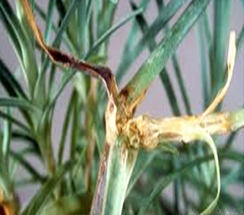Bacterial wilt Burkholderia caryophylli
Symptoms
- The upper parts of established plants turn pale and wilt. The stem develops elongated discolored stripes and split open which is characteristic of the disease.
- The roots are rotted partially and the cortical tissues become sticky and shows discoloration, a tendency to straighten out instead of remaining curled.
- The leaves are twisted. The roots are generally lacking on one side and remain discolored. The base of the cutting is discolored, with an elongated brown area extending upwards.
 |
 |
|
|
| Wilting |
Elongated discolored stripes |
|
|
Management
- Use of cuttings taken from upper parts of the healthy stock plants are less liable for infection and hence advocated as a control measure.
- Diseased plant debris should be collected and burnt. Overhead watering and splash watering should be avoided.
- Disease-free planting materials are to be used. Role cultivars viz., Elegance, Northland and Starlite are less susceptible to bacterial wilt.
Image source: University of Agricultural Science, GKVK, Bangalore |


